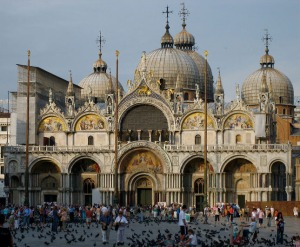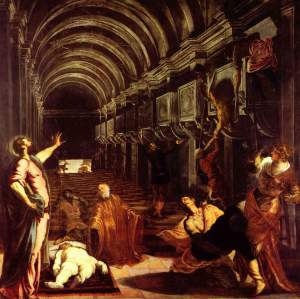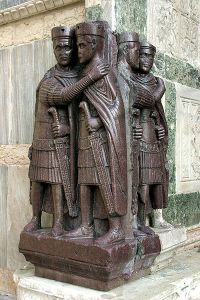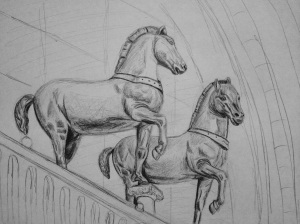St. Mark’s Basilica is a beautiful example of Byzantine architecture, located in the Piazza San Marco in Venice, Italy. It is no doubt one of the most well known churches in Italy, and it is adorned with 85,000 square feet of glittering mosaics, houses cherished relics, and is the resting place for many important leaders and the remnants of St. Mark himself (Hayes). However, its history is far from perfect, as it is rooted in theft and tainted by a murderous arson…
The church was built in tribute to St. Mark, but his relics were not acquired legally.
On January 31, 828, Venetian merchants stole the supposed relics of St. Mark the Evangelist and brought them to Venice. They were able to smuggle them past the guards by burying the relics beneath layers of pork in barrels in order to get them back to their homeland into the hands of Doge Giustiniano Particiaco. The Doge then had the relics placed in the chapel within his palace temporarily until a larger, safer church could be built to secure them (Hayes).
It is hard to understand how such a church could be started on the basis of theft, whether looking at it ethically or morally. However, back in those times relics were an important agent in unification both politically and socially, making it a bit easier to understand why stealing them could be allowed. Furthermore, St. Mark was the patron saint to the people of Veneto, as he had evangelized to them in the past (BasilicaDiSanMarco). It is not surprising, then, that such an extravagant church was built to house his remains.
The basilica known today is not the original – it has been built two times.

St. Mark’s Basilica
http://www.far3e.com
As aforementioned, the original building for the church was in the Doge’s Palace, and a larger church was built in 832. However, the building did not live long as it was burned in 976 in rebellion against Doge Pietro Candiano IV, in which they locked him inside to kill him while they set the building on fire. Restoration of the church began under Doge Domenico Contarini, and it was consecrated in 1094 (Hayes, Wikipedia). Unfortunately, the remains of St. Mark were nowhere to be found…
Legend has it that St. Mark himself revealed the location of his relics.
According to BasilicaDiSanMarco, the relics of St. Mark were lost, and the people of Venice were greatly distressed. After many days of prayer, tears, and fasting, it is said that St. Mark showed himself to the people gathered in the church along with the Doge and bishop by “extending an arm from a pillar which ancient tradition says was on the right hand side.” From then on, his remains were kept in the crypt of the church (BasilicaDiSanMarco).

“The Finding of the Body of St. Mark” -Tintoretto
http://www.wikipaintings.org
This story is portrayed in Tintoretto’s “The Finding of the Body of St. Mark,” showing the timeline from the people’s anguish as they search for the remains, to St. Mark showing his location in the pillar and the people lowering his body. Back in those times, people were much more open to “irrational” circumstances, especially as sensitivity to holy matters were widely promoted and popular.
The decorative nature of the basilica has continued to evolve through time.
Through the centuries, columns, statues, friezes and more were continually brought in by ship to decorate the church (Hayes). In fact, many of the treasures in the church were stolen from other cities. These include the “Horses of St. Mark” and the statue of “The Tetrarchs,” both taken during the sack of Constantinople during the Fourth Crusade (Wikipedia).

“The Tetrarchs”
http://www.wikipedia.org
I was continually surprised while researching St. Mark’s Basilica. There seemed to be so much shadiness involved as much of what makes the church today was attained through theft. Unfortunately it shows some of the poorer moments in the relationship between art and Christians. Its splendor, though, is undeniable. Even through such tainted history, God has still made the church into something beautiful, and today the art, stolen or not, can be admired and contemplated by many from around the world.
Sources:
BasilicaDiSanMarco. Procuratoria Di San Marco Venezia, 2004. Web. 10 Sept. 2013. <http://www.basilicasanmarco.it/WAI/eng/index.bsm>.
Hayes, Holly. “St. Mark’s Basilica, Venice.” Sacred Destinations. N.p., 19 Jan. 2011. Web. 10 Sept. 2013. <http://www.sacred-destinations.com/italy/venice-san-marco>.
“St Mark’s Basilica.” Wikipedia. Wikimedia Foundation, 19 Aug. 2013. Web. 10 Sept. 2013. <http://en.wikipedia.org/wiki/St_Mark’s_Basilica>.


It’s so ironic that a place of worship as well known and sacred as St Marks would be a place of so much corruption. I love what you said about turning a pile of wrong acts and producing such beauty. A powerful example of God’s redemption process.
It’s really cool to me that the painting we reflected upon at the beginning of class showed up once again in your presentation on St. Mark’s Basilica, as well as the fact that the people were more open to the circumstances of the irrational story of the finding of his body.
I visited this basilica on my Juniors Abroad trip; it’s very exciting to hear some more information about it, since the group leader didn’t know as much about it as he did with other landmarks. Being inside it is absolutely haunting; it’s both mysterious and beautiful. Almost all the lights were dimmed and there was a Gregorian choir singing in the back.
I didn’t realize there was so much corruption involved, but sadly, it doesn’t really surprise me. After learning about all the pilfering between European countries during the time of the Renaissance, I almost feel like we should just be grateful to have monuments open to the public at all. Not saying the history doesn’t matter to me, but the art definitely has more of a lasting impact on people and, as you said, makes up for the political corruption that went on behind the scenes.
I love the story behind St Mark. Whenever you hear stories like this, it makes you wonder if it actually happened, like they say it did, or if it is just a legend. I, personally, would love to just believe that it happened like that, but even though I say that there is the smallest bit of doubt. But that is just human nature for you.
I also love the building! It is enormous! I mean I know that I went to a lot of cool places this summer on Juniors Abroad, and even though I got a little tired of museums and castles, you can’t help but look at something like this and want to go there.
I enjoyed learning more about ST Marks Cathedral and also about the painting It is always enjoyable to learn the history and background stories behind the things you see and though some might be just stories it tells you about the people who created them by what they believed and painted. I have to wonder about the art that was stolen, I don’t agree with it and I have to wonder if it would have been safer left or whether they actually survived time better having been stolen but that is something I don’t think we can judge.